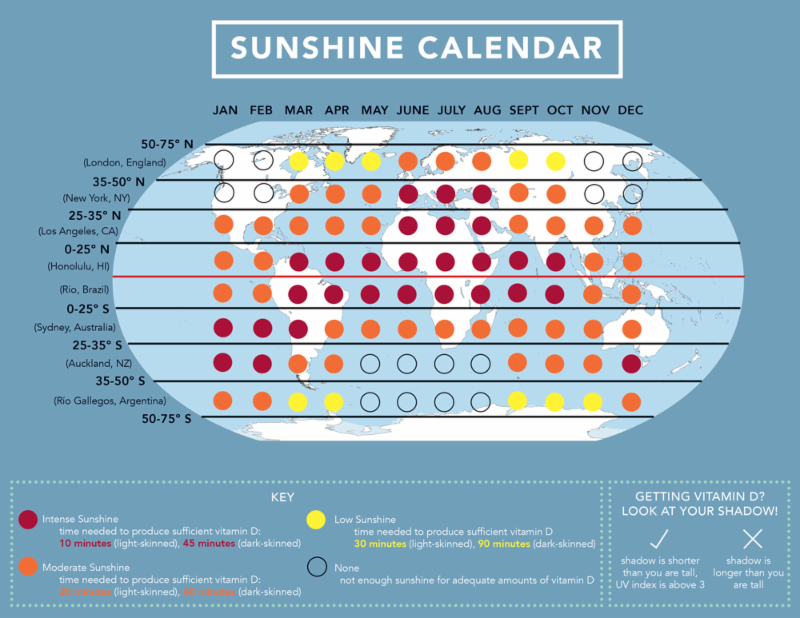|
Letter from the Director
I am always thankful for the many people who have participated in D*action. This initiative not only helps you find out, as individuals, your vitamin D status, but also helps GrassrootsHealth move research into practice by reporting on your data. At GrassrootsHealth we partner with leading researchers and epidemiologists to study this data.
This week we are looking at our population with respect to latitude. As you know, our cohort is not the normal world. The average serum level of a D*action participant is 44 ng/ml, as opposed to the world population which is reported to be around 16 ng/ml.
I love sharing your information with you. I am also eager to share some of the exciting news and outcomes of our current seminar, Vitamin D for Public Health - Integrating Sunshine, Supplements and Measurement for Public Health.

Thank you!
Carole Baggerly
Director, GrassrootsHealth A Public Health Promotion & Research Organization Moving Research into Practice NOW! |
|
Your Data, Your Answers - Latitude
This week we want to share your data with respect to latitude. The GrassrootsHealth D*action cohort, comprised of 7,123 members, is spread across 51 different countries. With such a diverse sample population, does location as measured by latitude play a part? How does intake of supplements affect serum levels across different latitudes? These are the questions we posed to ourselves and would like to share our finding with you in this newsletter.
Why do we Care about Latitude?
Vitamin D absorption from the sun is dependent on time of year and latitude. At the equator it is possible for your skin to produce vitamin D from sun exposure all year long. Above 35 degrees, you may only get vitamin D from the sun during spring and summer months, and this time decreases the further you get from the equator.
Below is a chart that shows possibility for vitamin D synthesis from the sun based on your global position. A clear circle means there is no chance for vitamin D production. A red circle means the sun is at its strongest. Find your location on the map. Look at the line of circles that are on the same horizontal row as your location. That will tell you the sun intensity by month for your latitude. Note that much of the industrial society is above the latitude where you can produce vitamin D year-long.

Knowing about seasonal vitamin D production, if we were solely getting our vitamin D from the sun, we would expect to see that our study population north of 40 degrees, is all vitamin D deficient. So... let's see what we have found...
Vitamin D Supplement Intake Similar Across Latitudes
As you can see from the graph below, supplementation is uniform across latitude - approximately 80% of our participants take some form of supplementation. The median latitude for participants is +/- 40 degrees.
Serum Levels of Participants Similar Across Latitudes
An average intake of 4000 IU/day for study participants results in a similar serum levels across latitudes. When we look at only those not taking supplements, we see that they also have similar serum levels, irrespective of their latitude. Could this be that our culture has us inside all the time?
|
|
As we finalize this newsletter, we are in the middle of our seminar, Vitamin D and Public Health - Integrating Sunshine, Supplements and Measurement for Optimal Health. We are learning a lot about sunshine, and how it helps keep us healthy - as a source of vitamin D - also as a stress reliever, and a regulator of circadian rhythms.
One of my big take-homes, as a resident of San Diego (32 degrees), is that I should get out daily at high noon, with minimal clothing (but a hat to protect my face), for about 15 minutes. For my fair skin this could make up to 20,000 IU of vitamin D and also help with many other preventive functions - blood pressure, cardiovascular disease, cholesterol, weight control - why wouldn't I take 15 minutes out in order to improve my health?
Next week we will summarize more from the seminar - but meanwhile - email me if you had a big take home from the seminar or from your time with GrassrootsHealth. I will summarize some of your comments in a future newsletter.
Here comes the sun!
Susan Siljander 
Marketing Director, GrassrootsHealth
A Public Health Promotion &
Research Organization
Moving Research into Practice NOW!
|
|
|
|
|
|
|
 |
|
| | Do You Qualify? | Women, 60+ years
Cancer-free
Test every 6 months
Sign up Now
|
|
|
|
|
Share this newsletter on Facebook! Click on the top left social share buttons to share this entire newsletter.
You can prevent disease if just one more person finds out about the preventative properties of vitamin D and starts moving their blood serum levels to 40-60 ng/ml.
|
|
|